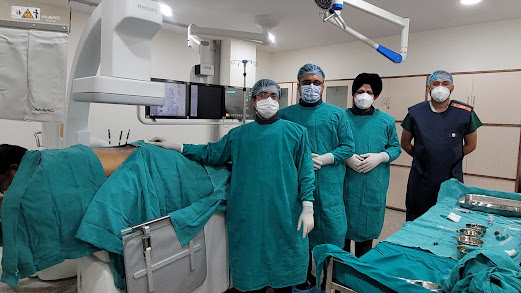Lumbar Sympathectomy in a Case with Foot Arterial Blockage Causing Intermittent Claudication
A chemical sympathectomy is an injection on the sympathetic nerves which run down the front of the backbone, close to, but outside the spinal column. Lumbar sympathectomy is a surgery that helps dilate tiny blood arteries in the skin and subcutaneous tissues. This can help reduce pain and improve circulation by severing the nerves that cause artery constriction.
What is the purpose of a lumbar sympathectomy?
Lumbar sympathectomy is used to treat leg and foot pain caused by a lack of blood supply, as well as to help leg and foot ulcers heal. To cure excessive perspiration in the foot and to reduce leg and back pain caused by spinal canal stenosis.
Raynaud's disease, arteriosclerosis, and thromboangiitis obliterans have all been treated by lumbar sympathectomy in humans. In individuals with resistant hypertension, catheter-based interventional techniques that interrupt the renal sympathetic neural system have demonstrated encouraging results in improving blood pressure control. Lumbar sympathectomy may be used to treat ischemia pain in the lower extremities caused by advanced peripheral vascular disease.
Sympathectomy using chemicals-
The high response rate obtained with local anesthetics percutaneous sympathetic inhibition prompted attempts to establish protracted blockage with phenol or alcohol injections using the same method. Three needle tips are inserted against the bodies of the L2, L3, and L4 vertebrae to accomplish this. Their placements must be radiographically validated. The needle tips should just touch the anterior border of the vertebral bodies in the lateral view. The points should lie over them in the anteroposterior perspective.
Lumbar sympathectomy may be used to treat ischemia pain in the lower extremities caused by advanced peripheral vascular disease. A prognostic lumbar sympathetic nerve block (LSNB) using a local anaesthetic medication may be performed prior to this therapeutic operation. The occurrence of a tolerable increase in skin temperature after LSNB supports the use of a therapeutic lumbar sympathectomy (by radiofrequency lesion or neurolytic blockade) to improve blood supply to the ischemic extremity. The role of the innervation sympathetic nervous system in chronic pain is frequently misunderstood.
Amputation of a limb produces severe physical and mental trauma, as well as substantial psychosocial problems and a poor quality of life. The agony of these people is exacerbated by persistent pain. Various treatments have been tested and proposed to help these individuals cope with their traumatic events and improve their quality of life. Stump pain is an acute nociceptive discomfort that is localised to the stump and occurs shortly after amputation. It normally goes away during the healing process of the surgical wound. When stump pain is not treated promptly, it can become chronic, impairing quality of life and rehabilitation.
Among amputees, persistent stump discomfort may contribute to the development of phantom limb pain. Postamputation pain is thought to be caused by a variety of spinal and supraspinal mechanisms. Increased afferent discharges from peripheral neuromas and dorsal root ganglionic cells may cause morphological and chemical alterations in the nervous system. The development of postamputation pain may be influenced by hyperexcitability and remodelling of the somatosensory cortex, central sensitization, and psychosocial variables.
Lumbar sympathectomy enhances lower limb blood circulation and tissue oxygenation, promoting early wound healing and preventing the development of persistent stump pain.
One of the major risk factors for postamputation pain is preamputation discomfort. The use of a lumbar sympathetic block prior to amputation can help to reduce limb sensitization and the development of stump and phantom limb pain.
Phantom limb pain is a chronic neuropathic pain that is similar in quality and location to limb pain prior to amputation.




Comments
Post a Comment